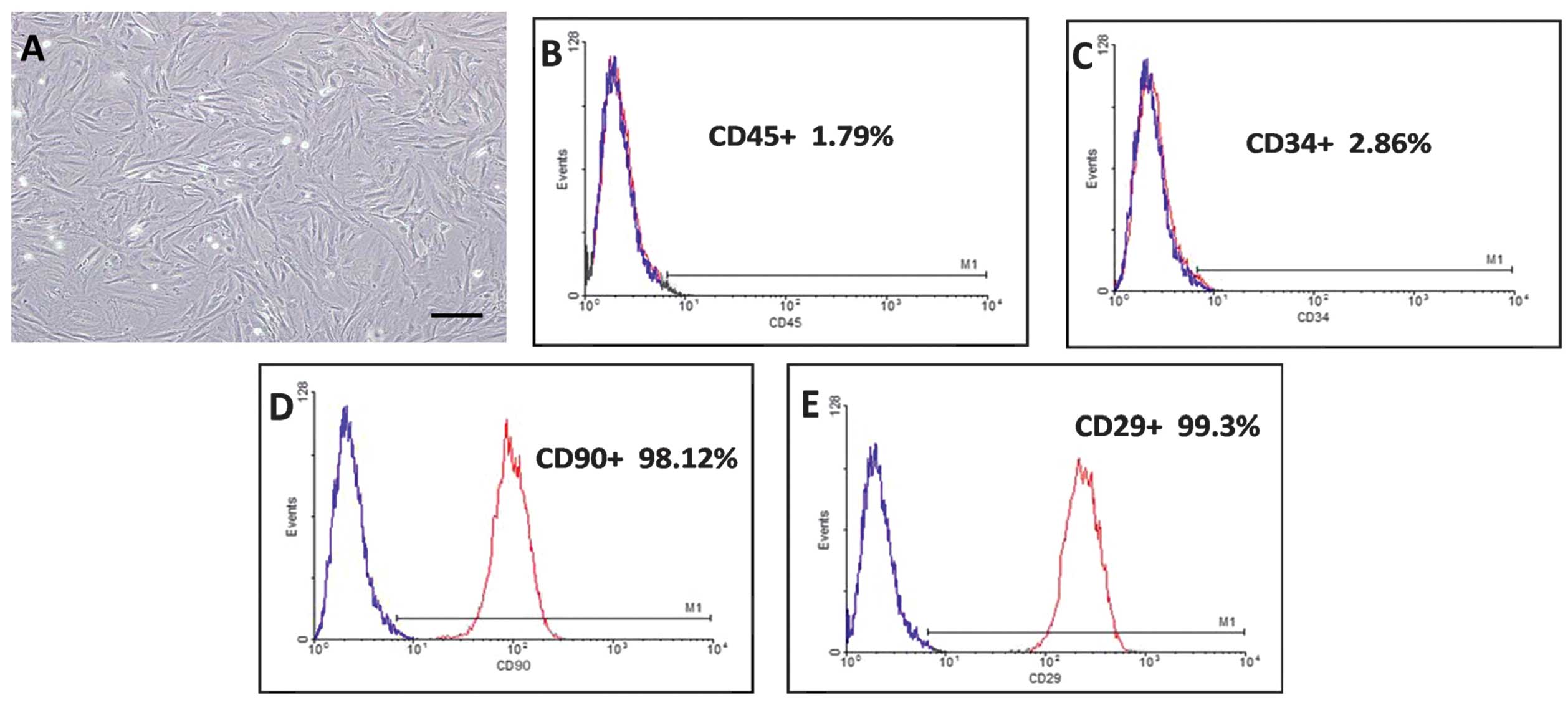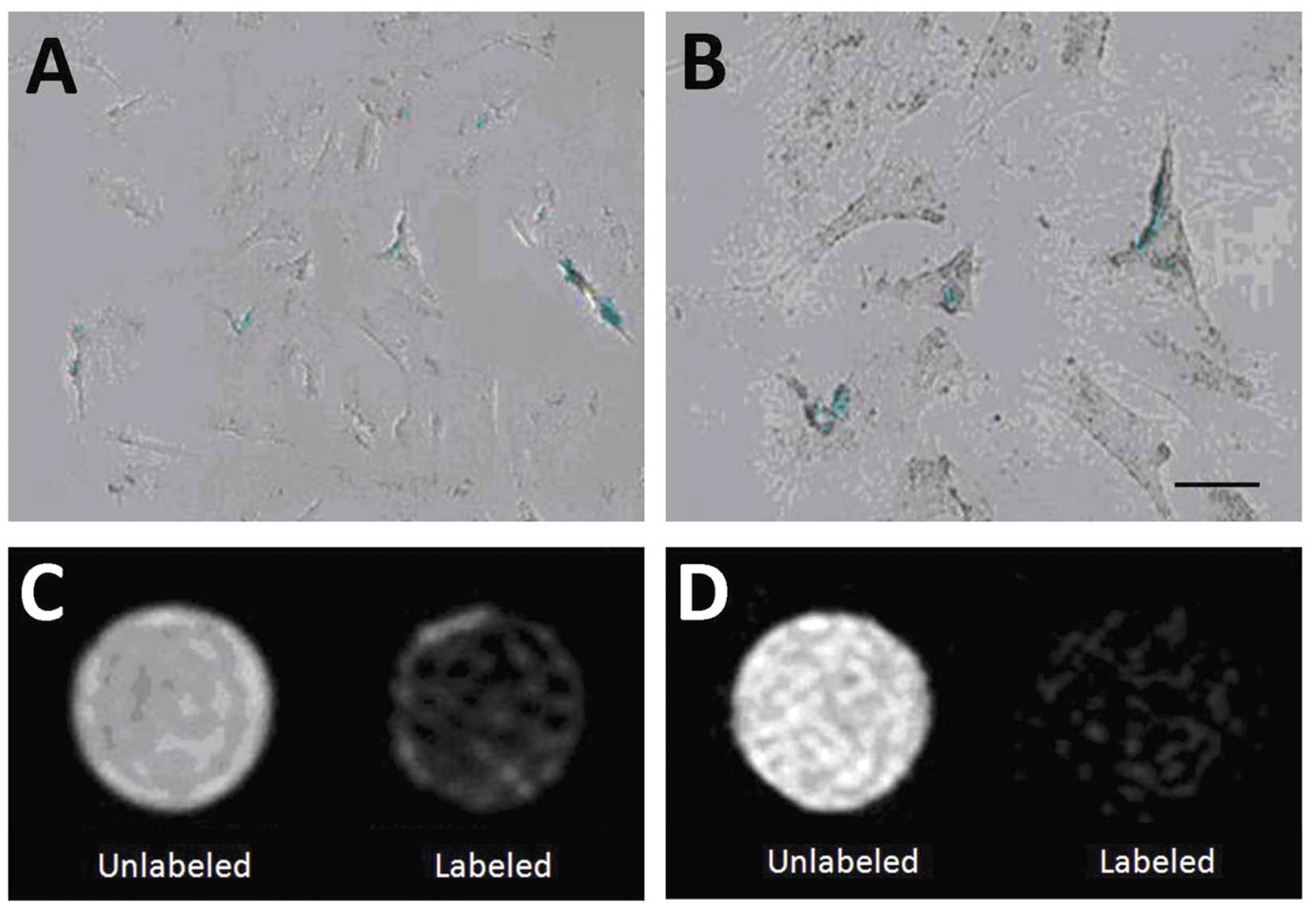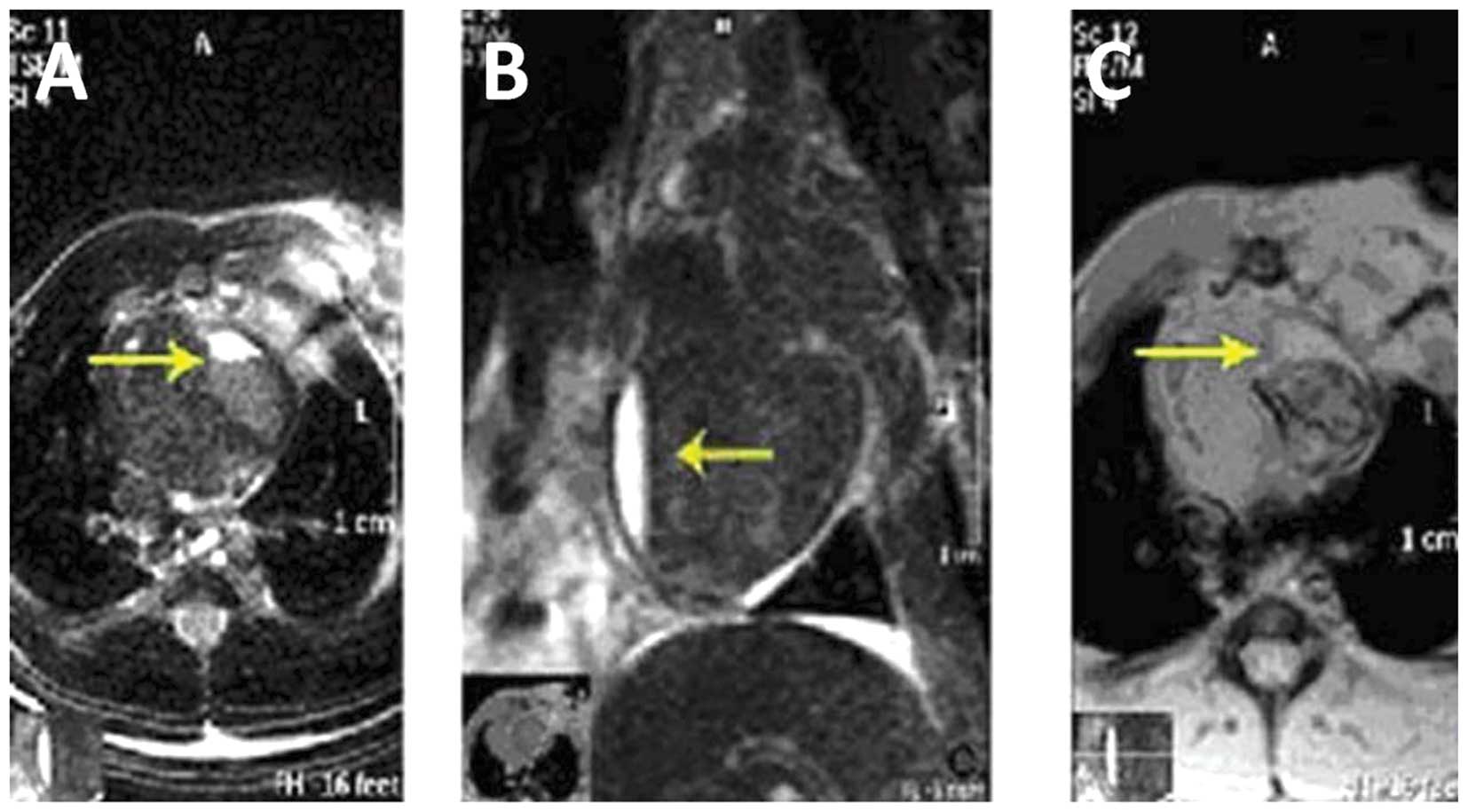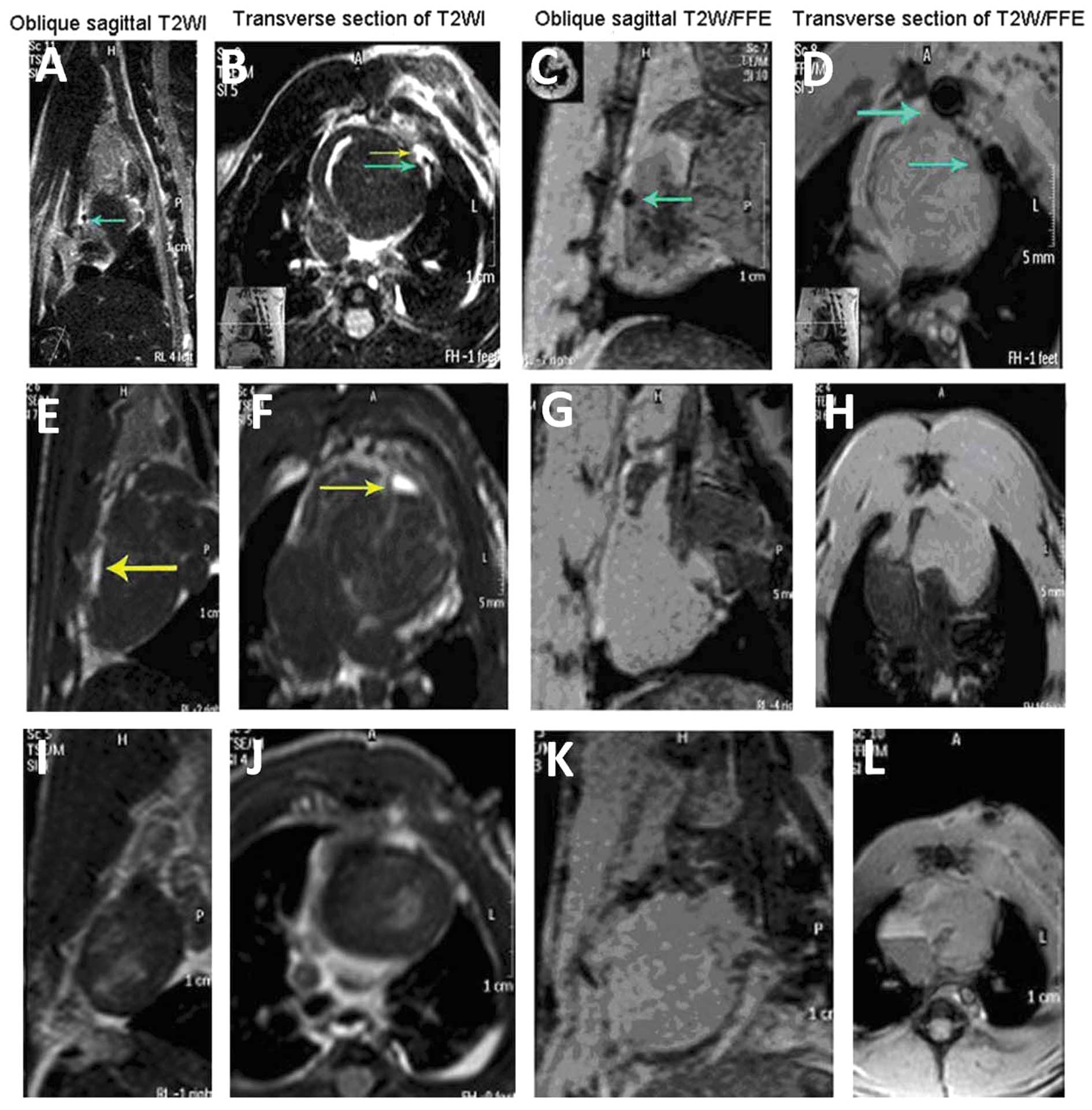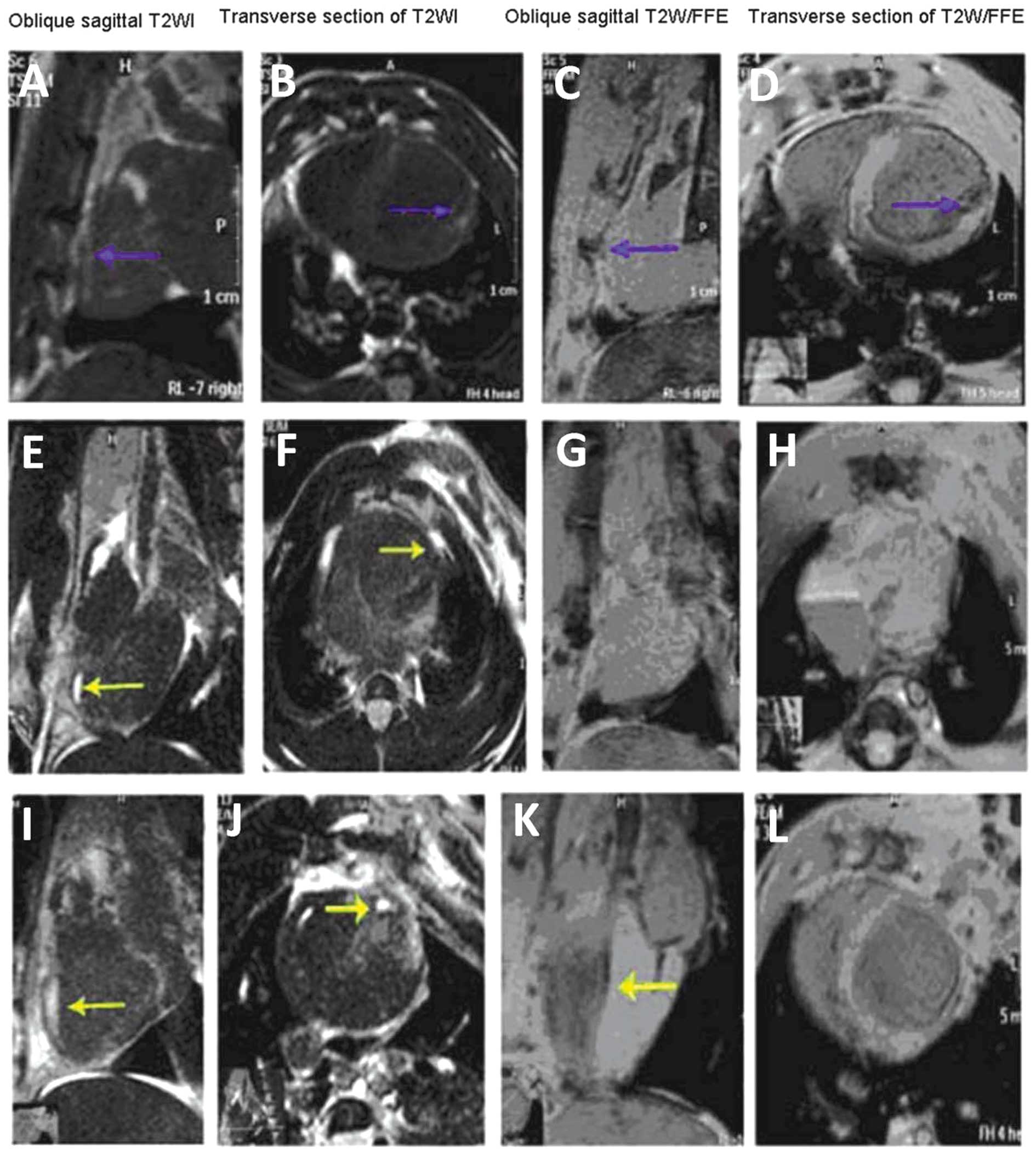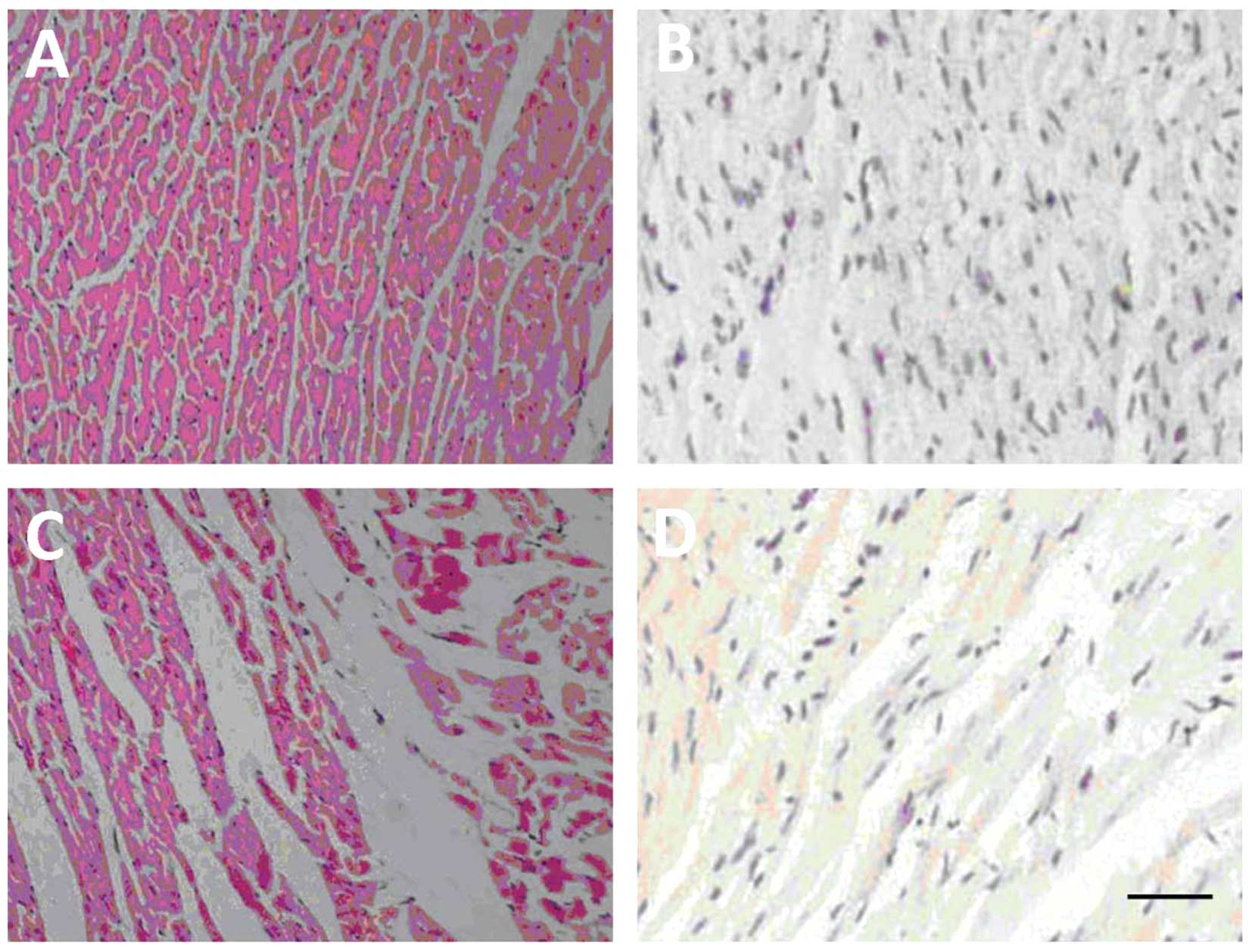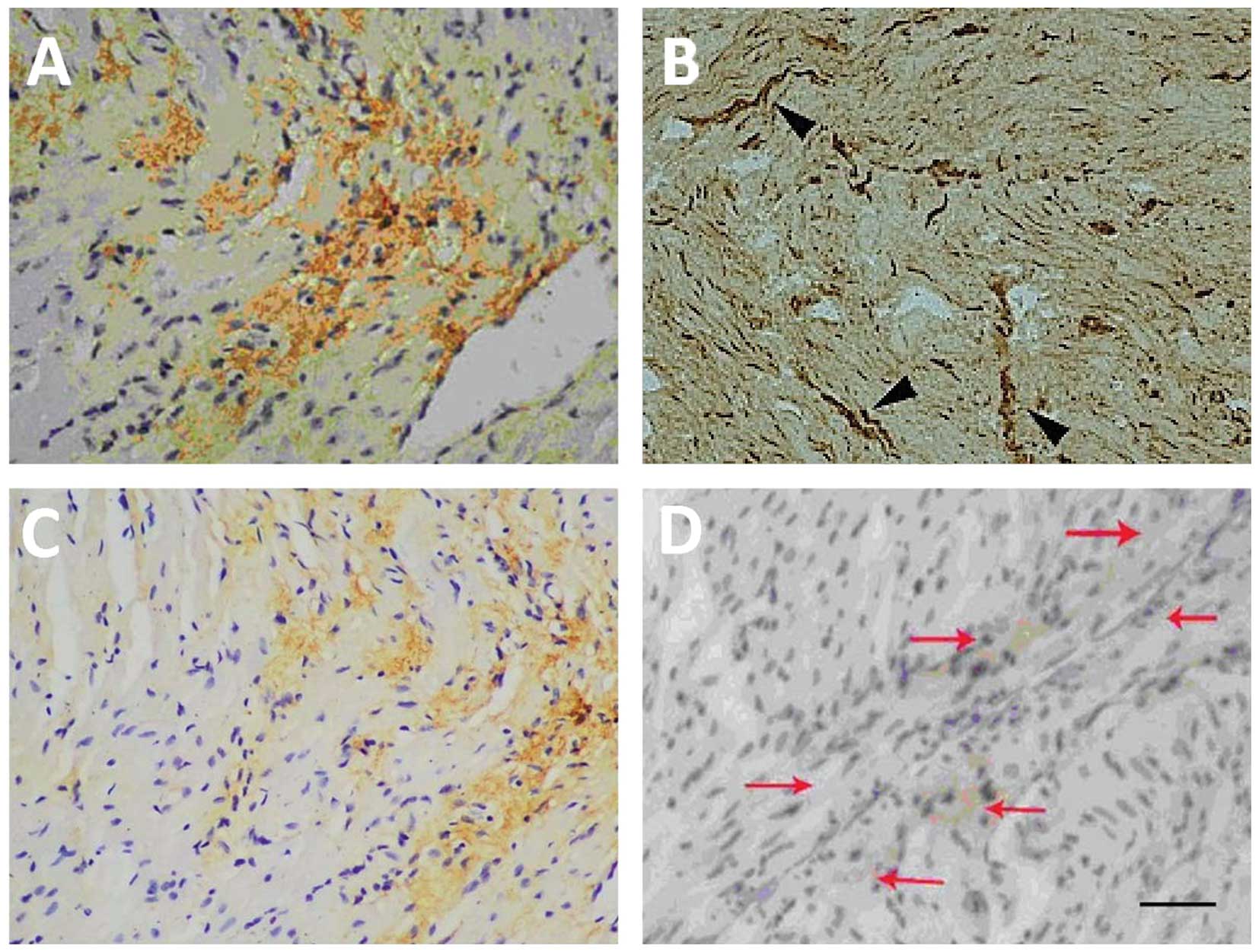|
1
|
Makino S, Fukuda K, Miyoshi S, et al:
Cardiomyocytes can be generated from marrow stromal cells in vitro.
J Clin Invest. 103:697–705. 1999. View
Article : Google Scholar : PubMed/NCBI
|
|
2
|
Anversa P, Kajstura J, Leri A and Bolli R:
Life and death of cardiac stem cells: a paradigm shift in cardiac
biology. Circulation. 113:1451–1463. 2006. View Article : Google Scholar : PubMed/NCBI
|
|
3
|
Feng X, He X, Li K, et al: The effects of
pulsed electromagnetic fields on the induction of rat bone marrow
mesenchymal stem cells to differentiate into cardiomyocytes-like
cells in vitro. Sheng Wu Yi Xue Gong Cheng Xue Za Zhi. 28:676–682.
2011.(In Chinese).
|
|
4
|
Orlic D, Kajstura J, Chimenti S, et al:
Bone marrow cells regenerate infarcted myocardium. Nature.
410:701–705. 2001. View
Article : Google Scholar : PubMed/NCBI
|
|
5
|
Bulte JW and Kraitchman DL: Iron oxide MR
contrast agents for molecular and cellular imaging. NMR Biomed.
17:484–499. 2004. View
Article : Google Scholar : PubMed/NCBI
|
|
6
|
Ju S, Teng GJ, Lu H, et al: In vivo MR
tracking of mesenchymal stem cells in rat liver after intrasplenic
transplantation. Radiology. 245:206–215. 2007. View Article : Google Scholar : PubMed/NCBI
|
|
7
|
Swijnenburg RJ, van der Bogt KE, Sheikh
AY, Cao F and Wu JC: Clinical hurdles for the transplantation of
cardiomyocytes derived from human embryonic stem cells: role of
molecular imaging. Curr Opin Biotechnol. 18:38–45. 2007. View Article : Google Scholar : PubMed/NCBI
|
|
8
|
Weissleder R: Molecular imaging: exploring
the next frontier. Radiology. 212:609–614. 1999. View Article : Google Scholar : PubMed/NCBI
|
|
9
|
Arbab AS, Bashaw LA, Miller BR, et al:
Characterization of biophysical and metabolic properties of cells
labeled with superparamagnetic iron oxide nanoparticles and
transfection agent for cellular MR imaging. Radiology. 229:838–846.
2003. View Article : Google Scholar : PubMed/NCBI
|
|
10
|
Bos C, Delmas Y, Desmouliere A, et al: In
vivo MR imaging of intravascularly injected magnetically labeled
mesenchymal stem cells in rat kidney and liver. Radiology.
233:781–789. 2004. View Article : Google Scholar : PubMed/NCBI
|
|
11
|
Bruce IJ and Sen T: Surface modification
of magnetic nanoparticles with alkoxysilanes and their application
in magnetic bioseparations. Langmuir. 21:7029–7035. 2005.
View Article : Google Scholar : PubMed/NCBI
|
|
12
|
Geraldes CF and Laurent S: Classification
and basic properties of contrast agents for magnetic resonance
imaging. Contrast Media Mol Imaging. 4:1–23. 2009. View Article : Google Scholar : PubMed/NCBI
|
|
13
|
Henning TD, Saborowski O, Golovko D, et
al: Cell labeling with the positive MR contrast agent Gadofluorine
M. Eur Radiol. 17:1226–1234. 2007. View Article : Google Scholar : PubMed/NCBI
|
|
14
|
Kim D, Hong KS and Song J: The present
status of cell tracking methods in animal models using magnetic
resonance imaging technology. Mol Cells. 23:132–137.
2007.PubMed/NCBI
|
|
15
|
Matuszewski L, Persigehl T, Wall A, et al:
Cell tagging with clinically approved iron oxides: feasibility and
effect of lipofection, particle size, and surface coating on
labeling efficiency. Radiology. 235:155–161. 2005. View Article : Google Scholar : PubMed/NCBI
|
|
16
|
Shen J, Zhong XM, Duan XH, et al: Magnetic
resonance imaging of mesenchymal stem cells labeled with dual (MR
and fluorescence) agents in rat spinal cord injury. Acad Radiol.
16:1142–1154. 2009. View Article : Google Scholar : PubMed/NCBI
|
|
17
|
Hill JM, Dick AJ, Raman VK, et al: Serial
cardiac magnetic resonance imaging of injected mesenchymal stem
cells. Circulation. 108:1009–1014. 2003. View Article : Google Scholar : PubMed/NCBI
|
|
18
|
Amsalem Y, Mardor Y, Feinberg MS, et al:
Iron-oxide labeling and outcome of transplanted mesenchymal stem
cells in the infarcted myocardium. Circulation. 116:I38–I45. 2007.
View Article : Google Scholar : PubMed/NCBI
|
|
19
|
Kraitchman DL, Tatsumi M, Gilson WD, et
al: Dynamic imaging of allogeneic mesenchymal stem cells
trafficking to myocardial infarction. Circulation. 112:1451–1461.
2005. View Article : Google Scholar : PubMed/NCBI
|
|
20
|
Frank JA, Miller BR, Arbab AS, et al:
Clinically applicable labeling of mammalian and stem cells by
combining superparamagnetic iron oxides and transfection agents.
Radiology. 228:480–487. 2003. View Article : Google Scholar : PubMed/NCBI
|
|
21
|
Hansen HA and Weinfeld A: Hemosiderin
estimations and sideroblast counts in the differential diagnosis of
iron deficiency and other anemias. Acta Med Scand. 165:333–356.
1959. View Article : Google Scholar : PubMed/NCBI
|
|
22
|
Tomita S, Li RK, Weisel RD, et al:
Autologous transplantation of bone marrow cells improves damaged
heart function. Circulation. 100:II247–II256. 1999. View Article : Google Scholar : PubMed/NCBI
|
|
23
|
Chen SL, Fang WW, Ye F, et al: Effect on
left ventricular function of intracoronary transplantation of
autologous bone marrow mesenchymal stem cell in patients with acute
myocardial infarction. Am J Cardiol. 94:92–95. 2004. View Article : Google Scholar : PubMed/NCBI
|
|
24
|
Lunde K, Solheim S, Aakhus S, et al:
Exercise capacity and quality of life after intracoronary injection
of autologous mononuclear bone marrow cells in acute myocardial
infarction: results from the Autologous Stem cell Transplantation
in Acute Myocardial Infarction (ASTAMI) randomized controlled
trial. Am Heart J. 154(710): e711–e718. 2007.
|
|
25
|
Beitnes JO, Hopp E, Lunde K, et al:
Long-term results after intracoronary injection of autologous
mononuclear bone marrow cells in acute myocardial infarction: the
ASTAMI randomised, controlled study. Heart. 95:1983–1989. 2009.
View Article : Google Scholar
|
|
26
|
Beitnes JO, Gjesdal O, Lunde K, et al:
Left ventricular systolic and diastolic function improve after
acute myocardial infarction treated with acute percutaneous
coronary intervention, but are not influenced by intracoronary
injection of autologous mononuclear bone marrow cells: a 3 year
serial echocardiographic sub-study of the randomized-controlled
ASTAMI study. Eur J Echocardiogr. 12:98–106. 2011.
|
|
27
|
Lunde K, Solheim S, Aakhus S, et al:
Intracoronary injection of mononuclear bone marrow cells in acute
myocardial infarction. N Engl J Med. 355:1199–1209. 2006.
View Article : Google Scholar : PubMed/NCBI
|
|
28
|
Meyer GP, Wollert KC, Lotz J, et al:
Intracoronary bone marrow cell transfer after myocardial
infarction: eighteen months’ follow-up data from the randomized,
controlled BOOST (Bone marrow transfer to enhance ST-elevation
infarct regeneration) trial. Circulation. 113:1287–1294.
2006.PubMed/NCBI
|
|
29
|
Paxinos G and Katritsis D: Autologous stem
cell transplantation for regeneration of infarcted myocardium:
clinical trials. Hellenic J Cardiol. 49:163–168. 2008.PubMed/NCBI
|
|
30
|
Schächinger V, Erbs S, Elsässer A, et al:
Improved clinical outcome after intracoronary administration of
bone-marrow-derived progenitor cells in acute myocardial
infarction: final 1-year results of the REPAIR-AMI trial. Eur Heart
J. 27:2775–2783. 2006.
|
|
31
|
Terrovitis J, Stuber M, Weiss RG, Leppo M,
Youssef A, Gerstenblith G and Marban E: Iron-labeled stem cells
seen by magnetic resonance imaging: dead or alive? Circulation.
114:2642006.
|
|
32
|
Arbab AS, Yocum GT, Kalish H, et al:
Efficient magnetic cell labeling with protamine sulfate complexed
to ferumoxides for cellular MRI. Blood. 104:1217–1223. 2004.
View Article : Google Scholar : PubMed/NCBI
|
|
33
|
Stuckey DJ, Carr CA, Martin-Rendon E, et
al: Iron particles for noninvasive monitoring of bone marrow
stromal cell engraftment into, and isolation of viable engrafted
donor cells from, the heart. Stem Cells. 24:1968–1975. 2006.
View Article : Google Scholar : PubMed/NCBI
|
|
34
|
Terrovitis J, Stuber M, Youssef A, et al:
Magnetic resonance imaging overestimates ferumoxide-labeled stem
cell survival after transplantation in the heart. Circulation.
117:1555–1562. 2008. View Article : Google Scholar : PubMed/NCBI
|
|
35
|
Zhou R, Idiyatullin D, Moeller S, et al:
SWIFT detection of SPIO-labeled stem cells grafted in the
myocardium. Magn Reson Med. 63:1154–1161. 2010. View Article : Google Scholar : PubMed/NCBI
|
|
36
|
Nagyova M, Slovinska L, Blasko J, et al: A
comparative study of PKH67, DiI, and BrdU labeling techniques for
tracing rat mesenchymal stem cells. In Vitro Cell Dev Biol Anim.
50:656–663. 2014. View Article : Google Scholar : PubMed/NCBI
|



